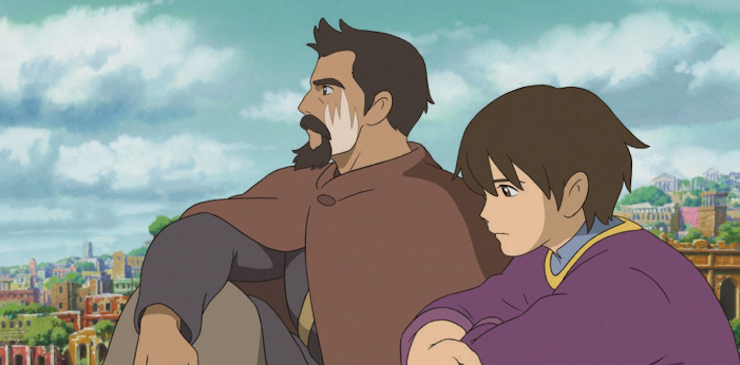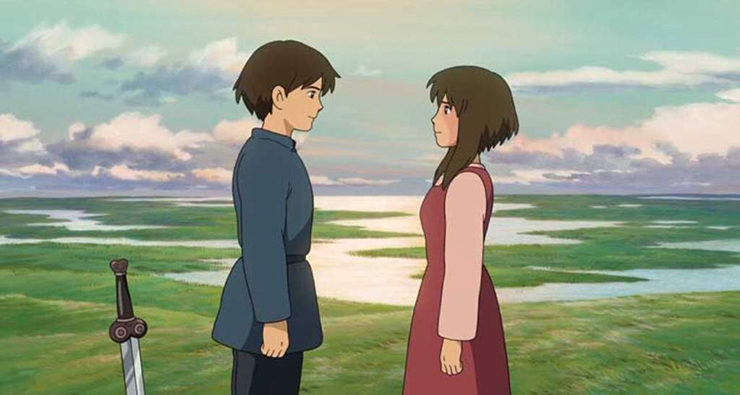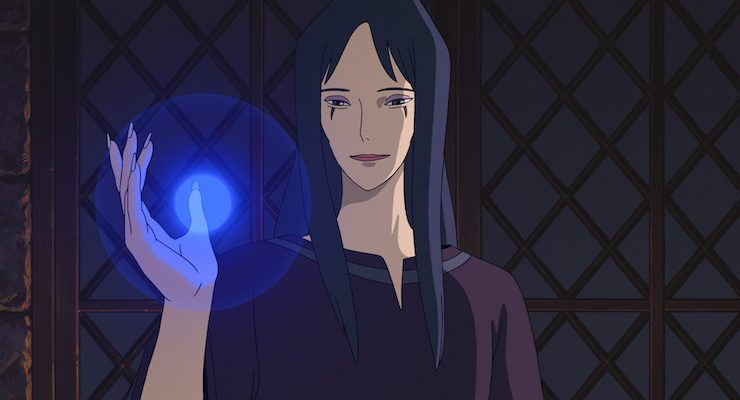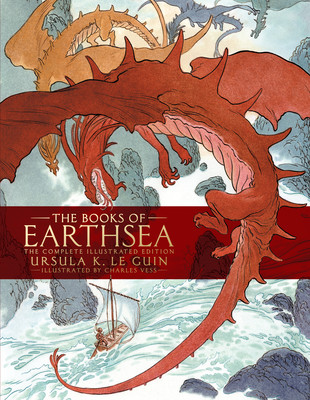The Studio Ghibli adaptation of the late Ursula K. Le Guin’s Earthsea series is notoriously bad. I’d heard the same reviews from Le Guin and Ghibli fans alike, long before I ever watched the 2006 film, and even long before I read the Earthsea novels themselves. Whitewashed, plodding pace, and a bizarre mash-up of four novels, a graphic novel, and a host of short fiction, the film seemed to garner even more vitriol than the average book-to-film adaptation (which is, let’s be real, a high bar).
When I finally sat down to watch this dark horse of the Ghibli oeuvre, my inclination wasn’t to like or dislike the thing, but to understand why the meeting of these worlds could fail so spectacularly in the eyes of the creators’ fans. After all, so much of what makes Ghibli and Le Guin wonderful is shared, the absolute beauty of their artforms aside. I’ve loved Ghibli since before I could read, and loved Le Guin since the first sentence of The Left Hand of Darkness. So why, within the first five minutes of their meeting, was I filled with more dread than excitement?
First, a brief overview: Tales of Earthsea was not directed by the much-lauded founder of Studio Ghibli, Hayao Miyazaki, but instead by his son and first-time director Gorō Miyazaki. It follows Prince Arren after he mysteriously murders his father and flees his kingdom, happening upon the mage Sparrowhawk only by chance. Sparrowhawk, who is investigating the disappearance of magic in the realm, takes Arren under his wing (literally! His scar is in the shape of a wing on his face, and it’s my favorite part of the movie). Arren rescues a young girl from slavers, who he later discovers is Therru, adopted daughter of Sparrowhawk’s friend Tenar. Therru is suspicious of Arren due to his bloodlust in battle, but comes around to him after singing a bafflingly long song about loneliness and realizing that they’re kindred spirits. This burgeoning young love is put on hold when Tenar is kidnapped by the earstwhile slavers, who, as it happens, are collecting sacrifices for a wizard named Cob, who is courting immortality and thus killing all magic in the land. Arren, terrified of death, is seduced into joining him, and since Sparrowhawk is a Very Busy Man, it is left to Therru to rescue Arren and Tenar. Afterwards, briefly, inexplicably, and unprompted, she turns into a dragon.

Fans of Le Guin’s book series will recognize many elements and plot points reshuffled into new formations in this description—The Farthest Shore is probably its driving inspiration, but Arren’s “possession” is a clear callback to Sparrowhawk’s in A Wizard of Earthsea, and Therru is only introduced in Tehanu. The movie’s resemblance to the Journey of Shuna graphic novel is also somewhat sideways, in that many Ghibli films, Princess Mononoke and Nausicaä most prominently, borrowed from it. But lines of similarity are some of the least interesting ways to read an adaptation—especially with a film so lifeless and weird. Did I mention that Therru randomly turns into a dragon?
Most important to me, though, are the ways that this movie fails the mission of the creators’ larger bodies of work. I wrote recently about Le Guin’s delicate dance between allegory/myth and emotional realism. It’s a dance that her works almost always step gracefully, that make for a poetry and richness that invites readers to return and reread over and over again. Studio Ghibli has much the same effect; though they are often compared to Disney, Ghibli deals in Big Ideas and unreal scenarios through very real, flawed humans. Tales of Earthsea keeps the big ideas and fantastical elements of those sources, but erases the human emotion. I found myself at turns confused by characters’ motivations (why did Arren kill his father?) and annoyed by the convenient ways that they slotted into the film’s themes (Therru decides she likes Arren just in time to rescue him). It’s difficult to appreciate a story’s take on ideas about mortality and love when those ideas are delivered by caricatures.

Another aspect of both the Earthsea series and Ghibli that I find laudable is their willingness to take their young audiences seriously. It’s another feature that differentiates Ghibli from Disney, and another that invites Le Guin readers of all ages into the pages of Earthsea. Both creators make fiction for children that allow them to explore real emotion and sometimes real trauma, safely. Tales of Earthsea, though, explains its own plot at every turn, having its characters narrate the film’s themes to one another. It portrays bloodlust, slavery, death, and prejudice without ever really exploring their consequences. It’s not that the film talks down to its young audience members; it’s that it doesn’t seem to know who its audience is at all.
And finally, the politics. The film’s whitewashing has been much-discussed—and rightfully so—by Le Guin herself and many others, and so I want to touch on another egregious piece of erasure: gender. Ghibli and Le Guin alike are known for their excellent, albeit very different, explorations on gender—willful, independent young girls in the case of the former, and boundary-testing folk of all genders in the latter. Tales of Earthsea keeps the iconic Ghibli protagonist in spunky Therru, but stumbles again and again to create any kind of meaning out of her spunk, instead relegating her to teaching Arren how to be Good. Tenar, my favorite character in the novels, is reduced from a morally complicated cult survivor to doting mother and patient lover and acolyte. Most offensive, though, is the movie’s villain, Cob.

An obsession with immortality is interpreted here as vanity, and as we all know, vanity is the domain of women—therefore the horror of Cob is illustrated through the unforgivable act of gender deviance. Feminine features, a whispering androgynous voice, and most horrible of all, the seduction of a young boy, make him a queer trope to be reckoned with, and a counterpoint to these creators’ otherwise fascinating record of gender critiques.
Buy the Book


The Books of Earthsea
Between this and the equally notorious 2004 Sci-Fi adaptation of Earthsea, it’s easy to see why some might consider the series unadaptable. Perhaps out of some misplaced optimism, I disagree. Certainly the quietness of Le Guin’s story-telling and the vastness of her world and mythos might lend themselves better to forms other than film—graphic novels, perhaps, or audio, or even an RPG—but we might also just not have found the right team of creators yet. As Gorō Miyazaki tried his hand at Earthsea, even, Hayao simultaneously crafted his own adaptation of another beloved fantasy novel, Diana Wynne Jones’ Howl’s Moving Castle, arguably one of the best in Studio Ghibli’s oeuvre. I’d not only try on another Earthsea adaptation, I’d try another Ghibli one. This film was a disappointment, but the pairing did make sense. It was, more than anything, a wasted opportunity.
And if anyone wants to make me eat my words in the next few years, that’s fine too.
Em Nordling reads, writes, and manages research in Louisville, KY.











I’m not sure if “whitewashed” is the right term, since the characters seem to be in the fairly standard anime style used to depict Japanese characters. White people tend to interpret those character designs as white because they’re simplified enough that we can project our expectations onto them, but I think Japanese viewers would see the faces in the above screencaps as Japanese — except Sparrowhawk, whose design suggests something Middle Eastern to me, what with the tan skin, the aquiline nose, and the cloak and headscarf he wears in other screencaps I find online.
I didn’t think it was terrible, but I do kind of wish for a fan translation that removed & replaced all of Le Guin’s names so that I could more easily divorce it from the source material.
@@@@@ 0: This burgeoning young love is put on hold when Tenar is kidnapped by the earstwhile slavers, who, as it happens, are collecting sacrifices for a wizard
What is erstwhile about the slavers? They don’t seem to have changed their ways a bit.
@1, CLB, in fact you’re quite correct. There are videos on youtube where Japanese people are show various manga / anime characters and asked which “races” they are representing, and most invariable answer Japanese, though there are a few people give other responses. More interesting is when they say why, and you can begin to see the Japanese representation that they are seeing. It seems like the faces are so universal that everyone sees themselves in them.
Re: Whitewashing, the problem isn’t that Asians are represented as Euro, or vice versa. The problem is that some (or all) of the characters are described in the book as having the dark brown complexion that here on Earth would be read as African ancestry. LeGuin complained about the representation of her characters on bookcovers, if I remember correctly. If I didn’t, I should have read the link kindly provided.
@5/Cool Bev: I’m not saying the film doesn’t have representation problems. Of course it’s true that the filmmakers changed the characters’ ethnicity to match their own culture’s majority. I’m just saying they changed them to look Japanese, not white, so “whitewashing” is the wrong word in this instance.
If anything, the Japanese have farther to go when it comes to portraying diversity than American creators do, since there’s so little ethnic diversity in Japan. One example is the Super Sentai franchise vs. its American adaptation Power Rangers. In Power Rangers, the Ranger teams are always consciously ethnically diverse; indeed, the current season’s six Rangers include only one non-Latin white actor, though the supporting cast is mostly white. But the Super Sentai casts are usually entirely Japanese, and the most diversity you’re likely to get is an ethnically Japanese actor playing a Chinese or Japanese-American character. In the Super Sentai franchise’s 43 seasons, there have been three recurring black characters played by two different actors, including an African-American police captain in the current season who’s the first black series regular in the franchise’s history (and who tends to be played for comic relief). So it was probably never likely that a Japanese production would portray LeGuin’s characters’ ethnicity accurately.
Honestly. I loved it. Still do. I get that you didn’t like it but you don’t have to write an anti puff piece about some sort of scientific analysis of why it sucked. It really touched my soul so it sticks with me and I watch it multiple times a year. If you don’t like it that’s fine. But the article you wrote was basically a summary plus general opinion, which is fine, but stop touting it as some sort of consensus among everybody that knows what a good anime/movie is. That’s a claim that no one can make
Here’s what Le Guin herself wrote on the subject of skin colour (found on her website in an article about the film):
“Most of the people in animes look – to the American/European eye – white. I am told that the Japanese audience perceives them differently. […] I hope so. Most of the characters look white to me, but there is at least a nice variation of tans and beiges. And Tenar’s fair hair and blue eyes are right […].”
The thing is, white Americans’ expectation of what ethnically Asian cartoon characters should look like is shaped by our own cultural stereotypes, like the assumption that Asian people have narrow, slitted eyes, which is actually a caricature, an exaggeration of the differences we perceive. So a non-caricatured cartoon representation doesn’t have the features we’re conditioned to expect.
Granted, the traditional anime/manga art style does have a lot of Western influence behind it — one of its primary formative influences is the Disney-inspired art of Osamu Tezuka — and a lot of anime and manga have given characters Westernized appearances (e.g. blond or red hair — or even green, blue, or purple) as a sort of aspirational ideal in a culture that’s had a complicated love affair with the West for generations. But of the Tales of Earthsea characters in the screencaps I can find, only Sparrowhawk and Tenar have any traits that would suggest non-Japanese ethnicity to a Japanese viewer.
Kate @@@@@ 4:
There’s a very useful discussion of this issue by Rachel Matt Thorn, who specializes in the study (and translation) of manga. One of the points, which agrees with what Christopher Bennett was saying, is that American/Western perceptions of manga and anime are biased by assumptions about the “correct” way to designate people of different ethnicities, in the sense of applying certain stereotyped visual markers as additions to/variations on some default norm.
She has an additionally relevant comment about stories set in non-Japanese contexts:
So, yeah, saying that the Ghibli film “whitewashed” the characters is erroneous, and is (perhaps ironically) an example of ethnocentric criticism. It is plausible to argue, as Christopher Bennett does, that it reflects something like a Japanese equivalent to whitewashing (i.e., “Well, we should make sure the characters look ‘normal’, i.e., like we do.”), combined with a failure to appreciate what LeGuin was trying to do in specifying skin color the way she did.
ChristopherLBennett @@@@@ 9:
The thing is, white Americans’ expectation of what ethnically Asian cartoon characters should look like …
I would only amend this to suggest that this is what all Americans expect, not just white Americans. (An African- or Asian-American, for example, might or might not approve of the particular visual signifiers, but they’ll recognize and expect them. In the essay by Rachel Matt Thorn I linked to in my previous comment, she argues that “If an American of Asian descent wants to create a children’s book intended to build self-esteem among Asian American children and educate other children about Asian American experiences, she must first make sure the readers know that the characters represented are Asian, and so, consciously or not, she resorts to stereotyped signifiers that are easily recognizable …”)
@10/PeterErwin: Or perhaps they did appreciate what Le Guin was trying to do, and that’s why there’s a “variation of tans and beiges” at all.
As I’ve never read the books, I don’t associate the film with them – and I think the film is great. Not the best of Studio Ghibli definitely, but a good film nonetheless.
I remember watching the film as a teenager, finding it to be boring and messy. As a huge Ghibli fan that really surprised me. It wasn’t until a few years ago that I actually picked up the books and now they’re honestly one of my favourite series!
It’s really heartbreaking to see a bad adaptation of something you love because all you can see is wasted potential. After reading the Howl books and knowing what a great job Hayao did with that film, it really makes me wonder what kind of film we would’ve ended up with if he had helmed Earthsea.
Oh well, I’ll always have my fingers crossed for a good adaptation one day!
Adapting into a Netflix show might not be a bad idea I feel. They have done well in adapting books like End of the Fxxxing World and A Series of Unfortunate Events without making the characters one-dimensional.
To me the film seemed to be like a pilot in a tv series that introduces the world and main characters main main conflict (lack of magic) and builds from there. It doesn’t work as stand alone movie or as adaptation but I did like the atmosphere.
I don’t agree with you about Disney however, the movies have plenty of big ideas and mature themes for those open to seeing them.